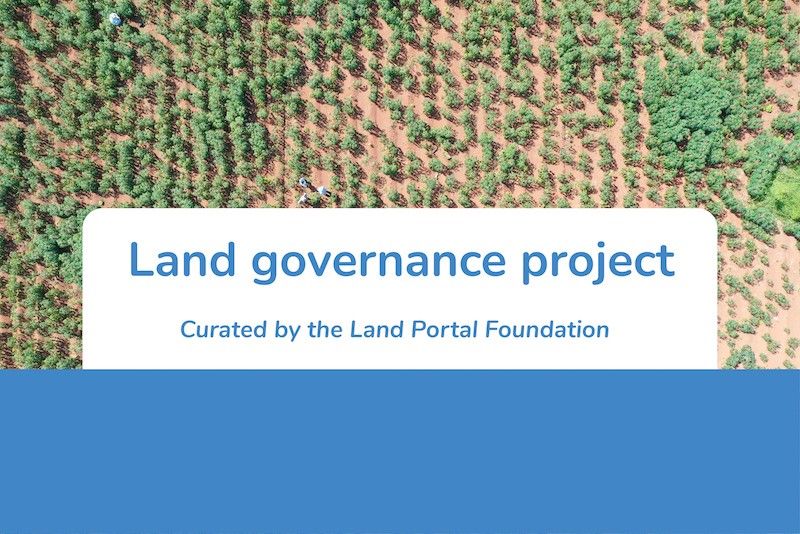Community / Land projects / Biodiversity protection through the Effective Management of the National Network of Protected Areas
Biodiversity protection through the Effective Management of the National Network of Protected Areas

€3725334.629
04/22 - 04/22
Completado
This project is part of
Implementing Organisations
Donors
Data Providers
Objectives
To conserve terrestrial and marine biodiversity by strengthening management of the Union of Comoros newly created Protected Areas Network through effective co-management with communities for sustainable development
Other
Note: Disbursement data provided is cumulative and covers disbursement made by the project Agency.
Target Groups
Local socioeconomic benefits include i) the development of sustainable income-generating activities for 6,399 people, 50% of whom are women and 4% are PWD through sustainable nature-based value chains related to PAs, securing or increasing food provision through improved ecosystems health and improvements to local communities’ production activities, including fishing and agriculture, and ii) increased capacity and opportunities to actively participate in the co-management of protected areas and resources and the valuation of the ecosystem goods and services they provide. National socioeconomic benefits provided by the project include i) preservation of assets for the development of tourism in Comoros including clean beaches and healthy ecosystems that support ecotourism, i.e. forests, coral reefs, and increased opportunities for tourism operators such as hotel operators, restaurateurs and communities that offer community lodging facilities, and tourist guides, ii) increased institutional capacities to co-manage PAs, ecosystems and species, and to preserve the country’s development potential and the ecosystem goods and services that the PAs provide and on which the local populations, the private sector and the government rely, including provisioning services such as fisheries and wild aromatic and medicinal plants, provision of water in watershed areas, climate and flood regulation, provision of fertile soil, green manure, shade and moisture for agriculture, fodder for livestock, pollination, waste processing and assimilation (in mangroves), and cultural, aesthetic and spiritual services. iii) increased capacities of the private sector and local community cooperatives to develop sustainable value chains based on resources from the PAs, and iv) establishment of a national certification system for sustainable and equitable products from protected areas. The 2016 National Strategy and Action Plan for Biodiversity emphasizes the importance, for human survival and well-being, of the essential services that biodiversity provides and concludes that biodiversity provides income to most of the population and constitutes the basis of the Comorian economy. Agriculture’s share – including fishing and livestock breeding – of the national wealth has been estimated at more than US$209 million, representing 41 percent of GDP and 90 percent of the country’s export income. Fishing provides nearly 40 percent of animal protein for the population, most majority of whom live in a subsistence economy, employs approximately eight percent of the population, and provides five percent of the country’s foreign currency. The ecosystem goods and services provided by coral reefs include 3,000 tons of reef fish/year, estimated at approximately US$6.18 million. Tourism is not highly developed and contributes only around 10 percent to GDP. Its offers only precarious, and nearly non-existent, benefits to local communities. However, the economic value of tourism services from the coral reefs in the marine area of Mohéli National Park is estimated at US$3.5 million. This is equivalent to 1.3 percent of GDP, 15.2 percent of public investments, and 10.7 percent of exports of goods and services. The tourist value of all of the country’s coral reefs is estimated at US$8 million. The component 3 of the project is focusing on partnerships between private businesses and community cooperatives directly or through the development or expansion of nature-based value chains and the strengthening of their capacities to ensure the sustainability and profitability of the livelihoods for local communities. It is expected that 6,399 people, 50% of whom are women and 4% are PWDs, will benefit from improved livelihoods through such sustainable nature-based value chains related to PAs. The project will first target vulnerable people whose resource use is detrimental to ecosystems (including fishers using nets or fishing on foot, people removing sand from beaches, and farmers cultivating under forest) How do these benefits translate in supporting the achievement of global environment benefits (GEF Trust Fund) ? Providing alternative livelihoods to local communities whose resource use is unsustainable will reduce pressures on coastal and forest ecosystems. Indeed, these people were met by the staff in charge of PA management and have expressed their willingness to give up their illicit activities as long as they can benefit from support to practice a profitable alternative activity. This will contribute to stabilize 17,564 ha of primary and secondary forest, 197 ha of mangrove, 6030 ha of seagrass beds and 30,000 ha of coral reefs within the PA network, thus increasing the protection of the habitats for endemic and threatened biodiversity such as the Livingstone fruit bat, island-endemic Otus, marine turtles, the Mongoz lemur, the dugong, and marines species living in association with reefs. Reducing the collection of shoreline materials will contribute to the natural restoration of marine turtle nesting beaches. The development of these livelihoods will be an incentive to local communities to support and collaborate in the management of PAs, thus contributing to increase management effectiveness over 116,577 ha of existing terrestrial and marine/ coastal protected areas which will lead, with the reduction of the rate of deforestation, to a reduction of the threats to endemic biodiversity in these areas and to increased mitigation of greenhouse gas emissions. To ensure that the project generates local and global benefits, interventions are aligned with STAP guidance, including § helping strengthen community land and resource tenure: the Project will contribute to clarify the issue of land tenure, particularly to ascertain the extent of community land ownership, or village terroirs, within the National Parks through output 1.2 on the development of master plans for terrestrial and marine/coastal areas within protected areas, and more specifically sub-outputs 1.2.1 on the participatory delineation and mapping of village terroirs within protected areas, the translation of the georeferenced coordinates of the PA boundaries and of zoning into local communities’ own reference system, the “lieux-dits”, and 1.2.3 on the participatory planning of land/coastal and resource use, including the delineation of areas reserved for the harvesting of natural resources by local communities involved in value chains – both planning processes will be supported by village co-management committees; these plans will be developed in parallel with strategic environmental and social assessments to ensure, inter alia, they do not restrict other people’s legitimate access rights. In this way, National Park management plans will incorporate land tenure issues in the review of park management plans and all community engagement activities, in order to capture accurately tenure and community engagement in National Park management. The project will document the boundaries of the different zones as well as the conflict zones. Any physical demarcation will be carried out with the collaboration of local communities and will be limited to areas that are not the subject of any dispute. The documentation of conflicts will identify the nature of the conflicts, the disputed areas, and the communities or community members involved. While it is possible that the project might not have the means and time to resolve all the conflicts identified, this exercise will at least provide a common and updated basis for all concerned parties, including the National Parks Agency, communes and concerned village authorities, to work on jointly and resolve land disputes. § promoting equitable benefits from wild resources through sub-output 3.3.2 focused on the identification and implementation of partnership agreements that guarantee tangible and optimized benefits to community cooperative partners in the value chains; support will be provided to value chains stakeholders to negotiate and develop long-term, mutually beneficial "win-win" partnership agreements and provide a framework for the development of value chains that guarantee a fair share of tangible benefits to partner communities; this principle must be reflected in the business models and support will be provided (as part of output 3.4 related to strengthening entrepreneurship capacities and the design of business models) to each business in designing or adapting their business model to incorporate the maximization of benefits to local communities through benefit-sharing rules so that the benefits derived from these value chains provide adequate incentives for local communities to comply with PA regulations; § supporting effective community governance through capacity building and more specifically through interventions under the sub-output 1.1.4: Recognition and consolidation of the effective involvement of men and women from local communities in the governance of protected areas, including i) the explicit recognition of their rights and benefits related to natural resources in PAs and revision of village co-management agreements to include these rights and benefits, ii) the establishment of grievance redress mechanisms in each park and informing local communities and other stakeholders about the mechanism for registering, forwarding, evaluating and resolving grievances; § and building local capacity to manage natural resources through sub-output 2.2.2: Plans for the sustainable use of species targeted for the development of value chains, where training will be provided to local communities on sustainable harvesting in the natural environment (harvesting techniques, quantities, frequency, period determined on the basis of the studies carried out by specialized biologist) and to enable their participation in the monitoring of the quantities harvested, the evaluation of the condition of the exploited populations on the basis of simple indicators which will have been identified by a plant biologist or a fishery biologist, and decision-making regarding any required adjustment to harvest levels, including if necessary, putting an end to it. These trainings will be developed and provided on site by the biologists specialized in flora and fishing who will ensure a follow-up of these trainings after 6 months to ensure the good understanding of the shared concepts. The Ecoguards and Mobilizers of the relevant parks will also participate in these trainings in order to ensure an adequate supervision of the local communities on a continuous basis. The likelihood of this project having positive conservation outcomes is supported by the long-term relationship between conservation stakeholders and local communities, which has helped build trust and open communication. The numerous discussions between the staff of the National Parks Agency and people who practice illicit activities that lead to the degradation of ecosystems and resources (for example net fishermen and sand collectors) confirm the latter's will to voluntarily cease these practices if they have the opportunity and the required support to develop and practice an alternative profitable activity. It is clear from these meetings that the local communities in each of the protected areas are largely favorable to PAs and aware of the importance of biodiversity conservation, through several years of successive interventions supported namely by UNDP, starting with the UNDP-GEF G32 project which established the Mohéli Marine Park and introduced the co-management concept, the UNDP-UNV CBO project (Community Base Organizations) which aimed to raise awareness and build the capacities of local communities to prepare them to co-manage the future protected areas in other sites, and then the project GEF ID 10351 which set up the protected areas system, including the establishment of 5 new PAs.




